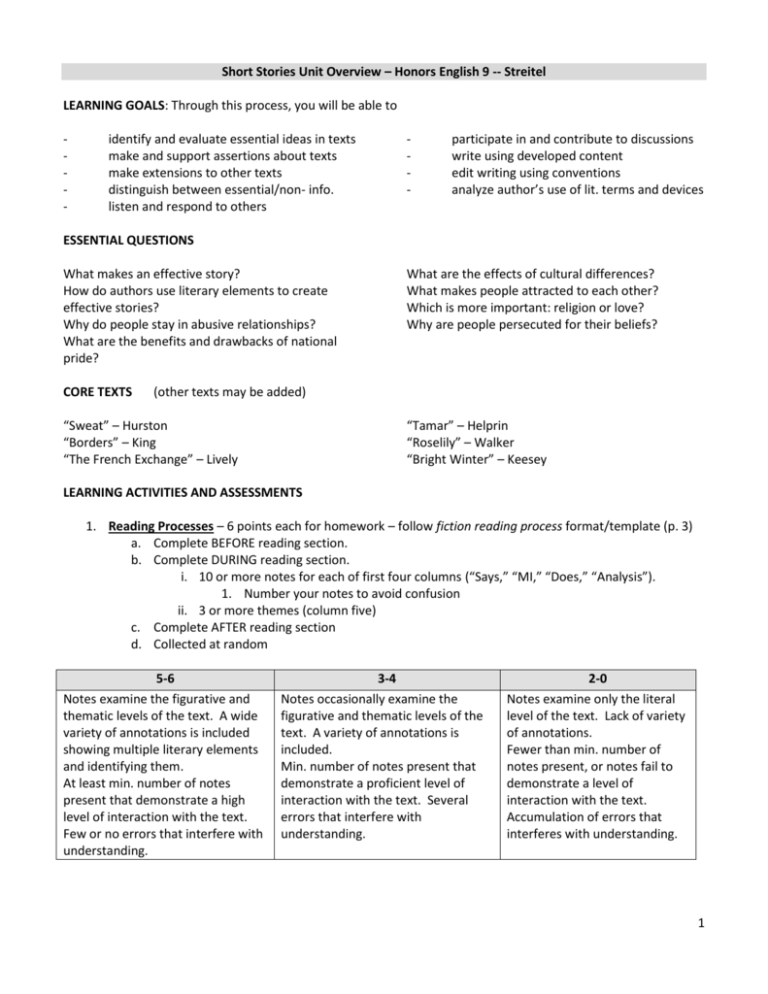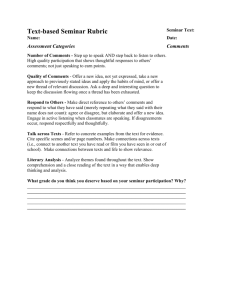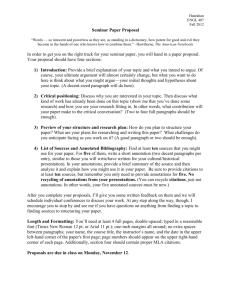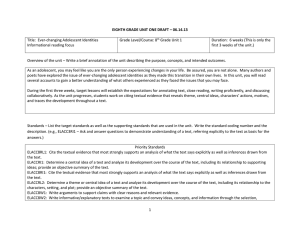Overview
advertisement

Short Stories Unit Overview – Honors English 9 -- Streitel LEARNING GOALS: Through this process, you will be able to - identify and evaluate essential ideas in texts make and support assertions about texts make extensions to other texts distinguish between essential/non- info. listen and respond to others - participate in and contribute to discussions write using developed content edit writing using conventions analyze author’s use of lit. terms and devices ESSENTIAL QUESTIONS What makes an effective story? How do authors use literary elements to create effective stories? Why do people stay in abusive relationships? What are the benefits and drawbacks of national pride? CORE TEXTS What are the effects of cultural differences? What makes people attracted to each other? Which is more important: religion or love? Why are people persecuted for their beliefs? (other texts may be added) “Sweat” – Hurston “Borders” – King “The French Exchange” – Lively “Tamar” – Helprin “Roselily” – Walker “Bright Winter” – Keesey LEARNING ACTIVITIES AND ASSESSMENTS 1. Reading Processes – 6 points each for homework – follow fiction reading process format/template (p. 3) a. Complete BEFORE reading section. b. Complete DURING reading section. i. 10 or more notes for each of first four columns (“Says,” “MI,” “Does,” “Analysis”). 1. Number your notes to avoid confusion ii. 3 or more themes (column five) c. Complete AFTER reading section d. Collected at random 5-6 Notes examine the figurative and thematic levels of the text. A wide variety of annotations is included showing multiple literary elements and identifying them. At least min. number of notes present that demonstrate a high level of interaction with the text. Few or no errors that interfere with understanding. 3-4 Notes occasionally examine the figurative and thematic levels of the text. A variety of annotations is included. Min. number of notes present that demonstrate a proficient level of interaction with the text. Several errors that interfere with understanding. 2-0 Notes examine only the literal level of the text. Lack of variety of annotations. Fewer than min. number of notes present, or notes fail to demonstrate a level of interaction with the text. Accumulation of errors that interferes with understanding. 1 2. Seminars – 3 at 3 points each = 9 points for homework a. Follow INFORMAL seminar format as discussed in class b. Use annotations to guide your discussion c. Offer outside connections (cited with facts) when possible d. During seminar, share your ideas, respond at least TWO times – agree/disagree, offer a new point or opinion, make a prediction – ask questions, share connections Conduct Reasoning Listening Preparation & Participation 3 2 1 Demonstrates respect for learning process; has patience with differing opinions and complexity; asks peers for clarification; attempts to involve others; moves forward into new concepts; not disruptive Speaks to all participants; avoids talking too much; can be heard by all Generally shows composure but may display impatience with contradictory or confusing ideas; not patient while waiting to speak; comments frequently and sometimes engages others Addresses majority of comments to peers; does not try to say “everything” while speaking; responds to questions voluntarily; tries to speak louder when asked to do so Displays little/no respect for the seminar process; argumentative; takes advantage of or causes distractions; Reluctant to speak when called on or passes; cannot be heard; shows no desire to contribute verbally; may use inappropriate language Understands questions before answering; cites evidence; provides logical and insightful comments; makes connections between ideas; resolves apparent contradictory ideas; considers others’ viewpoints not only own; avoids poor logic; provides possible answers to own questions Demonstrates some reflection on concept but not mastery; makes limited connections with ideas of others; ideas interesting enough that others respond to them; uses generic evidence Makes illogical comments; says little more than “I agree”; ignores previous comments and seminar direction; may use humor to avoid serious thinking; fails to use evidence Listens for opportunities to respond; does not overlook details; takes notes/writes questions; builds on discussion; points out flawed reasoning; overcomes distractions Generally attentive and focused; responds thoughtfully to ideas/questions raised; may be too absorbed in own thoughts to hear others’ comments; may write some notes but not consistently Not attentive to others; exhibits negative body language; takes no notes Understands major concepts; has student-prepared notes and questions; participates at least 2 substantive times Demonstrates knowledge of facts ; participates at least 1 time Clearly unprepared or fails to participate (not speaking at all is a grade of 0.5) 3. Reading test – 60 points for tests DATE: ___________________ a. Covering all stories and associated information presented in class b. Short answer & MC questions 2 Short Stories Fiction Reading Process Name ________________________ Text ___________________________ Pages/section ____________ BEFORE READING 1. Author’s purpose: 2. What I Already Know (WIAK) about the topic: 3. What I predict about the reading: a. Beginning: b. Break 1: c. Break 2: 4. Questions to be answered (1+ and specific to section): a. Beginning: b. Break 1: c. Break 2: DURING READING 1. What the author says (plot, setting, characters) 10+ 2. Main ideas (not facts—what do these details indicate?) 10+ 3. What the author does (style, POV, tone) 10+ 4. Analysis (not facts—why might the author use these devices or stylistic choices?) 1+ per item from column 3 5. What the author means (themes, morals—complete sentences, not single words) 3+ -- identify items from columns 1-4 that lead you to each theme Show us why . . . Provide a sense of . . . Explain the decision/action . . . Lead us to conclude that ... Show us the importance of . . . Help us see evidence for ... Make us feel . . . Help us understand . . . Help us visualize . . . AFTER READING 1. Answer BEFORE questions (#4 above) if possible: 2. Write down confusions you encountered (words, lines, actions, ideas, etc.) and questions you still have: 3 4








